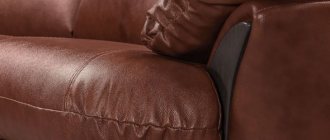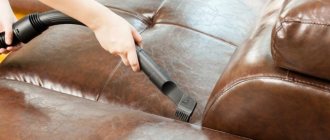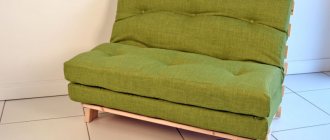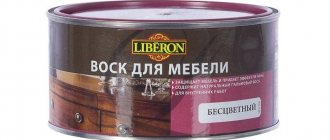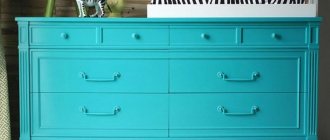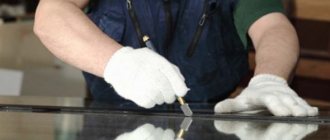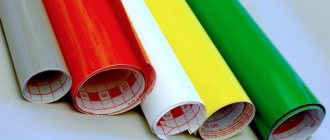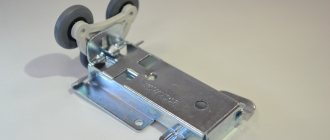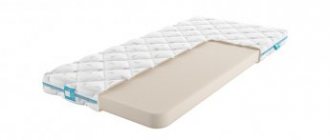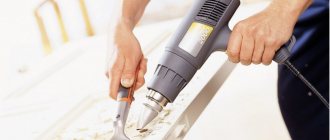Everything flows, everything changes. So the popularity of leather furniture has been slightly replaced by leatherette products. Visually, they add solidity to any room. A sofa or soft corner in a classic style, upholstered in faux leather, secretly emphasizes the high status of its owner and fits perfectly into any environment, be it an office, apartment or restaurant.
Modern leather substitutes are durable, high quality and are not much inferior to their natural counterpart. This covering will not emit toxic substances; it is also called eco-leather. This material is most often used for upholstery of various pieces of furniture.
Leatherettes are distinguished by the base, which can be either cotton or polyester. Cotton-based material is a little more expensive, but easier to care for. However, follow a number of simple rules - and caring for leatherette furniture will not be difficult and will allow you to maintain the attractive appearance of the product.
Leather or not? Determining the type of material
Speaking about how to care for leather products, it is worth giving a few tips with which you can distinguish natural from artificial upholstery :
- natural material, if you put your palm on it, immediately heats up, artificial material does not;
- natural quickly restores its shape and does not change color when deformed;
- natural material has a very dense structure, as well as a rough edge;
- artificial upholstery does not absorb moisture, emits a strong chemical aroma, and has a fabric base.
If you don’t know how to identify a leather product, then simply look at the manufacturer’s instructions, which indicate the type of material that was used in the production of the upholstery. By the way, in the instructions or on the sticker (located on the bottom of the furniture) you will find recommendations for caring for the product; let’s look at some of them:
- W – cleaning with a special water-based product;
- S, P – cleaning using solvent (dry cleaning);
- SW, WS – cleaning with water-based agents, solvents (dry cleaning), steam cleaner;
- X - only dry cleaning performed by professionals is acceptable.
Also, the manufacturer can apply manipulation (vector) signs to the label, for example, “Keep away from moisture,” “Keep away from the sun,” and others. They pay attention both when packing and transporting goods, and during direct operation!
How to care during the warm season
Since there is quite a lot of dust in summer, it is recommended to take more care of your shoes. It must be cleaned daily and areas with scratches and damage must be touched up, because in the summer the artificial material fades. The cream is selected based on its color and type.
Tips and tricks
In order for your shoes to last for a long time, you should wash them regularly and follow the recommendations:
- Clean daily with a dry cloth or damp sponge.
- Do not wash under running water, do not allow complete immersion in water.
- Caring for leatherette with specially designed products.
- Dry when wet. You can fill it with newspaper and leave it in a dry place.
- Do not expose to hot air.
- Apply water repellent in the rain.
- Use products that are designed to protect artificial leather.
Folk remedies
In summer, artificial leather can be damaged by various substances. For example, if organic components such as blood, animal urine or saliva come into contact with it, the steam should be treated. A mixture of detergent and ammonia in a 1:1 ratio, which should be poured with a glass of water, will help with this. Use a sponge to treat the dirty area on the shoes, then after ten minutes wipe them with a damp cloth.
Food marks can be removed with shaving foam. It is applied, rubbed in with a cloth, and washed off after a while.
Important! If shoes are stored in inappropriate conditions, red spots appear on them. In this case, a mirror surface cleaner is suitable.
Special care products
If the owner has shoes of a color for which cream is very difficult to find, you can treat them with a colorless product. One of these is KIWI Express Shine, which comes in sponge form. It is suitable for daily use.
One of the modern means for easy processing of leatherette is liquid leather. It restores the leatherette, making it look perfect. An example is Renovatrice cream. It is enough to use it a couple of times a week. It creates the effect of new, just purchased shoes. Helps restore fake skin even in severe cases.
Many people prefer to purchase artificial materials for many reasons, one of which is the humane treatment of animals. Today this topic is gaining significant momentum, leatherette is becoming more popular. Since it is often necessary to care for leatherette shoes, quite a large number of special products are produced.
How to protect leather furniture from wear and tear?
Genuine leather, which distinguishes it from artificial leather, tends to quickly absorb moisture. If you spill liquid on the upholstery, it is recommended to remove it immediately without rubbing it on the surface of the sofa or chair. Simply place a cloth or towel on the wet area and gently press the product with your hands to absorb excess moisture. After this, wipe dry.
Please note that leather furniture cannot be dried using a hairdryer, iron or heating appliances , because heating will lead to deformation, fading, and drying out of the material. Because of this, such sofas and armchairs cannot be installed near windows, avoiding direct sunlight , as well as near:
- air conditioners,
- heating radiators,
- gas or electric stoves,
If sunlight hits the furniture during the day, this is normal, but direct UV rays must be shaded by covering the windows with light curtains or blinds. Never cover a leather product with plastic if you are going to leave for a long time. A thick film creates a greenhouse effect; moisture will accumulate on it, which can destroy natural upholstery in the shortest possible time. In this case, it is recommended to order dry cleaning of the leather sofa at home, after which the furniture will be treated with protective compounds. It can be left for a long time without shelter!
How to properly clean leatherette?
- First of all, you need to prepare the equipment necessary for cleaning and a set of cleaning products.
- You need to remove all floor coverings from the sofa or cover them with film.
- Position the sofa so that natural light falls on it evenly.
- Under no circumstances should leatherette be dried in direct sunlight or heating devices.
- Do not use aggressive chemicals - chlorine, acetone and pure alcohol.
- Do not use metal brushes or other sharp objects that could damage the upholstery of the sofa.
How to properly care for a leather chair and other types of furniture?
We'll cover some basic tips to help you make your leather look new, but check the label before you start cleaning!
- You need to vacuum using the softest attachment. Collect dust from upholstery carefully, minimizing contact of the brush with the material.
- Remove any remaining dust with a soft, damp cloth, and then be sure to wipe it dry to prevent moisture absorption. For this cleaning stage, use distilled water, which does not contain harmful impurities and salts.
Twice a year it is necessary to treat the upholstery with leather conditioner , which will slow down the wear process, prevent deformation, drying out and the subsequent formation of cracks in the material. Air conditioners are produced in the form of aerosols; during use, they are sprayed onto a sponge, and then rubbed into the upholstery, left for 2-3 minutes, and then polished using a cloth. Before use, be sure to test the composition on a small area of skin!
What should not be used to clean leather furniture?
In the question of how to refresh leather products, we must not forget about the properties of this material. It reacts poorly to moisture, as well as the following types of household chemicals:
- oils and varnishes;
- bleaches, ammonia-based compounds;
- cleaning products with abrasive particles;
- polishes and cleaning solvents.
You may only use products that are labeled “For Leather Products.” They clean and restore such upholstery well, and will also be the best assistant in the question of how to soften leather products. Avoid dubious folk remedies , such as the use of lard, alcohol, vegetable oil, because sometimes after them it is simply impossible to restore the upholstery.
To clean the type of material in question, you should not use soap or detergents , no matter how high quality they are.
Soap washes away the oils that the human body restores, but a sofa upholstered in genuine leather, as we understand it, does not. Even if you have used a soap solution, after using it the skin must be thoroughly dried and the entire surface treated with a special conditioner!
What else can be used to clean leatherette?
If you don’t trust folk remedies or they didn’t have the desired effect, then you can buy a special universal action product - LOC liquid bleach (brand - Amway). Environmentally friendly household chemicals will preserve the structure of the fabric and its color, removing all types of dirt from any surface. The substance does not need to be washed off, as it is safe.
Difficult stains can be removed with dry cleaning products. Before using them, you need to read the instructions for use. Procedure:
- Mix concentrate and water in a ratio of 1:10.
- Pour the liquid into a spray bottle.
- Treat problem areas.
- Wait 5 minutes.
- Wipe the surface of the sofa with suede or a soft washcloth.
Do's and don'ts
Items made from eco-leather and other synthetic materials require careful care. Depending on the type of contamination, different cleaning agents are allowed.
The following can be dangerous for any product made from eco-leather or leatherette:
- excess moisture;
- exposure to high temperatures;
- cleaning with a steam generator;
- abrasives.
Chemical solvents should be used with caution. Some of them can damage the surface.
You cannot use powdered soda, brushes or hard sponges - they will leave scratches, dirt will penetrate deeper, and it will be impossible to get rid of them. If the surface is glossy, dull spots will remain on it after cleaning with abrasive agents.
Before using any substances, it is better to test on a piece of material or an inconspicuous area of the product!
Types of leatherette
Before you clean the surface of the sofa, you need to find out what type of material you are working with - eco-leather, vinyl artificial leather or Apatek. Depending on the type of coating, a special set of chemicals is selected, for example:
- Eco-leather - it is best cleaned with a 40% water-alcohol solution or nail polish remover. After cleaning, the sofa should be wiped dry.
- Vinyl leather - solvents cannot be used for it; it is better to give preference to substances that contain ammonia.
- Apatek - solvents and chlorine-containing substances cannot be used for it. It is better to clean such leatherette with a soapy solution.
Daily care
Seats, sofa armrests, and bags made of white material become greasy over time and acquire a yellow tint. Denim clothing leaves bluish or gray stains on the seat. How to wash eco-leather from everyday dirt?
For this you will need:
- laundry soap;
- dishwashing liquid;
- wet wipes for caring for leather items;
- citric acid solution or lemon juice to whiten the surface;
- automotive leather cleaning products;
- melamine sponge eraser.
When choosing a car product for eco-leather, you will have to experiment - not all of them cope with dirty deposits in the same way; sometimes using laundry soap is easier and more effective.
Citric acid or hydrogen peroxide provide good whitening. The second, moreover, kills bacteria, which is useful for animal owners.
How to properly wash a leatherette product?
Eco-leather does not need to be wet much; all work is carried out with a wrung-out cloth. For washing you need a soft sponge and two dry cotton or microfiber cloths. You need to wipe off the dust first so as not to roll the fluff across the surface.
The procedure is as follows:
- Apply a small amount of cleaning solution or foam with a sponge. Rub gently.
- Remove the composition with a clean damp cloth.
- Wipe with a dry cloth to remove any remaining moisture.
- Apply a protective agent with silicone - it softens the surface, adds shine and forms a film that prevents contamination. Be sure to wipe off excess with paper towels.
Unfortunately, housewives also have to wash more complex stains. Tips for removing common stains will help keep your white finish clean.
Traces from pens and felt-tip pens
If there are children at home, the question of removing traces of their art sooner or later arises in every mother. Fortunately, modern felt-tip pens can be easily washed off with water, but the same cannot be said about ballpoint pens and markers.
Ballpoint pen ink is the most difficult stain to remove. They must be removed as quickly as possible so that the dye does not become embedded in the coating. If the ink is not dry, there is a chance to wash it with soap and a melamine sponge. After drying, you can whiten the surface stained with a pen in several ways.
- Method 1. Nail polish remover. Cleans off fresh ink, markers, and gel pens.
- Method 2. Hairspray. Apply, wait a couple of minutes, wipe off with a cotton pad, repeat if necessary.
- Method 3. Leather polish and solvent for polyurethane glue. First, treat the surface with polish or conditioner to protect it, wait 5 minutes, and then wipe the stain with a solvent. When used correctly, this treatment removes even old hand marks without harming the leatherette.
Methods using slaked soda, alcohols, and citric acid will remove the ink of gel pens and water-alcohol-based markers. Since ballpoint pen paste has a wax-fat composition, these methods will be ineffective for it.
Caring for new shoes
The current advice when buying new shoes made of artificial leather is to immediately buy a model that matches not only the size of the foot, but also its individual characteristics, since stretching synthetic leather is not an easy task. Imitation materials are not so flexible and quickly become unusable if you try to wear them on your feet for a long time.
Shoes, boots, and sneakers made of artificial leather that are tied with laces should not be tightened tightly - the punched holes are torn and the shoes quickly lose their aesthetic appearance.
Three times impregnation with a water-repellent spray, which is mandatory for leather shoes after purchase, does not have the same benefit for a synthetic surface and can even damage the shoe frame. It is best to simply treat a new pair with a good cream with organic ingredients in the form of wax or paraffin.
Remember a few simple rules, following which you can maintain a decent appearance for a long time, even a budget model:
- From wet shoes it is permissible to remove only the dirt that has adhered to the sole;
- Any cleaning, stain removal, color restoration is carried out only on a completely dry product;
- Drying - away from heat dissipators. If you really need to dry your shoes faster, you can use a hairdryer turned on at minimum heat and dry your shoes with it from a distance of no closer than 30 cm.
Shoes stored in a box should be taken out from time to time and checked to see if the leather is dry. As a preventative measure, those boots or shoes that are destined to spend several months in the closet should be treated from time to time with a dry brush to remove dust and lubricated with a nourishing cream.
Natural remedies
Keep this reminder on how to quickly remove stains of various origins from shoes using available means, and a new pair will not become too expensive to care for:
- Traces of chocolate and caramel are wiped off with a paste made from grated glycerin soap and water;
- Resin and melted rubber can be removed more easily if you apply a cloth soaked in turpentine oil to the stain for 10 minutes, and then carefully wipe the damaged area with movements in one direction;
- Simple stains in the form of sweet or milk drinks spilled on shoes can be removed with a soap solution;
- Using a melamine sponge, you can remove marks from a ballpoint pen or felt-tip pen (which is especially important for light-colored shoes);
- Oily and greasy stains are removed with pure turpentine;
- Traces of grass are removed with lemon juice or table vinegar diluted 1:3.
You can try to wash fresh, newly created stains of any origin with dishwashing detergent diluted in water. After the procedure, the remaining chemical substance should be wiped off with a damp cloth.
Professional products
New, newly purchased shoes do not require creams with a coloring or restorative effect. It’s better not to skimp on good preventive and caring options:
- Creme de luxe, Saphir - comes in the form of a plastic tube with a sponge, which allows you to regulate the intensity of the substance applied to the surface of the shoe. The cream contains resins with a high fluorine content and natural wax of 33% concentration. Together, these two leading components maintain a sufficient level of moisture in the material, preventing cracking and providing a stable shine, which intensifies during polishing;
- Salton “Shine Express” is a cream for smooth artificial leather that does not require polishing for the final result. Acts as a nourishing base, softening rough areas of the outer shoe frame and smoothing out microcracks on the surface. Prevents the skin from wrinkling on the boot or in the toe area, where folds often form.
Any cream or emulsion should be applied to a clean and dust-free shoe surface.
Drink Stains
At home, it is quite possible to wash traces of drinks from a white sofa. The main thing is to act quickly so that the liquids do not have time to be absorbed.
- Use a dry cloth or napkins to collect any remaining spills from the surface. If you don't have paper towels or a rag on hand, you can sprinkle salt, then collect it along with the absorbed drink.
- Wipe the stained area with hydrogen peroxide, an aqueous solution of vinegar or citric acid, if the pigment remains. The proportions of 9% vinegar to water are the same as when using acid: one to one.
- After treatment, wash the leatherette with soapy water or wipe with damp cloths, dry the surface with towels.
Proper care of leatherette shoes
Properly caring for artificial leather does not mean purchasing a full arsenal of expensive products and then expecting that their mere presence can perpetuate inexpensive shoes.
Before using any of the drugs purchased or prepared at home, you need to study the nature of the leatherette and correctly identify it by type of manufacture and external data.
In addition, the substitute imitates not only smooth leather and you may need to pay attention to methods for caring for shoes made of velor (artificial, of course), suede or nubuck.
Below are the products that are considered included in the basic kit for the proper care of shoes made from analog materials of smooth leather:
- A cream that matches the color of the shoe and has a moisturizing effect, since artificial leather is prone to drying out;
- Dye for masking abrasions, microdamages or color fading;
- Protective moisture-repellent creams containing natural waxes and paraffins. Attention! - such shoe creams dry out quickly, which is externally expressed in cracking of the surface of the substance, loss of uniformity of the substance. Such damaged products must not be used;
- Liquid emulsions in bottles, applied primarily to lightweight items intended to be worn in warm weather;
- Gloss creams, as a rule, come complete with a special sponge, or in the form of a sponge soaked in a solution, packaged in a plastic case;
- Spray deodorant to eliminate odors is a necessary attribute for any closed shoes made of leatherette, as well as winter boots or boots;
- A cleaner in the form of a foam or gel substance that helps cope with severe stains;
- Brush and separate sponge for dry cleaning;
- A flannel napkin or cloth for wiping the leatherette surface dry.
We’ll talk further about the rules for the appropriate care of different types of leather, but now we’ll list the prohibitions that apply to all types of analog leather substitutes:
- Shoes made of leatherette or other types of synthetic material cannot be machine washed, dry-cleaned, or attempted to remove dirt by completely immersing them in water;
- It is prohibited to use regular gasoline, acetone-containing solutions, and alcohols;
- Exposure to hot air and direct sunlight is detrimental to imitation leather.
The best option to wash a product made of smooth artificial leather is to add 10 mg of simple shampoo to 0.5 liters of warm water, soak a piece of soft cloth in the foamy solution, wring it out and thoroughly wipe the contaminated areas. Be sure to first clean your shoes from dirt using a dry foam sponge or a brush with natural bristles.
Nubuck
Artificial nubuck is equally divided into advantages and disadvantages relative to real leather products. Thus, shoes made from a synthetic substitute are less breathable, more susceptible to wear and tear, but such a product also tolerates moisture more easily, is less clogged with dust and does not fade as much in the sun.
For proper dry care of eco-nubuck, soft suede brushes and the most ordinary car vacuum cleaner are used, which will carefully remove dust and remaining dry dirt from the pile. For wet cleaning, use highly purified gasoline or soapy water to wipe the soles. It is allowed to use ammonia diluted with water (1:3) if salt stains cannot be cleaned in the usual way.
Suede and velor
These materials, made on the basis of ordinary cotton, serve, as a rule, no more than two seasons, but if such shoes are worn only in exceptional cases and each time you carefully approach the care of the fragile pile surface and the subsequent storage of the pair, the life of the product can be extended up to several years.
Artificial suede tolerates wet washing well, but after each procedure, the boots must be completely dried at room temperature, stuffed with wrapping paper.
In winter, synthetic velor or suede will retain their appearance, provided that the temperature does not drop below −200C. It is best if shoes prepared for such extreme wear are treated in advance with nanospray, which increases the stress resistance of polyester products.
Products for different types of stains
Leatherette and eco-leather are popular because of their practicality. This coating is washable and does not require complex maintenance. Most stains can be easily removed with soap, but some stains will require a little more effort.
- Food stains - greasy marks, chocolate - are washed off with dish gel marked “Anti-grease” or laundry soap.
- Stains from berries and grass should be bleached after washing with citric acid or hydrogen peroxide.
- The blood is immediately washed off with cold water, and a cotton pad with ammonia is placed on old stains. Then scrub, adding ammonia as needed.
- Nail polish, acrylic paint, brilliant paint are washed off with nail polish remover.
- Chewing gum and plasticine are first carefully wiped off with a gauze swab, and the residue is removed with alcohol.
- Gouache and watercolor can be washed with liquid soap and a melamine sponge.
- Oil paint can be wiped off with turpentine.
Rules for removing stains
Paradoxically, furniture and things made of white leatherette have advantages over colored ones, because when scrubbing their surface, there is no risk of washing off the dye and getting a lightened stain.
7 simple truths about stain removal:
- It is easier to remove fresh stains.
- All stain removers must first be tested on an inconspicuous area of the product.
- Do not scrape off dirt or use abrasives.
- It is necessary to erase traces of brush, paints, and brilliant green, moving from the edges to the center.
- When removing a stain, you need to change the cotton pads more often so as not to smear the dirt.
- Cotton balls should be proportionate to the size of the stain. It is better to remove some stains with cotton swabs - this will reduce the area of treatment, and therefore the risk of rubbing off pigmentation and damaging the surface.
- Eco-leather conditioner will help protect a white sofa, armchair, and chair upholstery - it must be applied after each wash. The silicone film on the surface will prevent the absorption of dirt.
When purchasing items made from leatherette, it is advisable to ask the seller about the type and composition of the material, and also to keep the flap that the manufacturer attaches to the label of the product or furniture. On this piece you can test the effect of stain removers, if necessary.
Source: mschistota.ru
How to care for eco-leather furniture
Like any work of art, eco-leather furniture also needs care. To understand the nuances of care, it is important to know the features of this material.
Refined and elegant, pleasant to the touch and practical, eco-leather products are very similar to natural ones. This high-quality substitute for genuine leather is very often used today in the manufacture of furniture. It consists of cotton, genuine leather, synthetic polymers and modern artificial materials based on cellulose. Additional softness, strength and elasticity of eco-leather are provided by the latest production technologies. The polymer film is applied to the cotton base without deforming the latter at all. Polyurethane guarantees eco-leather not only extremely high wear resistance and frost resistance (up to – 35°C), but also the ability to “self-heal”. If eco-leather furniture is slightly scratched or deformed, this damage will soon be restored on its own, delighting you again with the amazing beauty of your furniture.
Most experts value eco-leather for the fact that it does not emit any hazardous substances during operation, allowing air molecules and water vapor to pass through, but not water. In addition, the breathability of eco-leather is much higher than that of genuine leather. The environmentally friendly composition and physical and chemical properties of eco-leather guarantee its hypoallergenicity: it does not cause skin irritation and is odorless.
Consumers love eco-leather furniture for its delightful combination of incredible comfort and reasonable cost. Indeed, furniture made from eco-leather is not inferior in quality and aesthetics to furniture made from genuine leather, but at the same time, the costs of purchasing home furnishings made from eco-leather are much lower.
In order for this magnificent furniture to decorate the interior of your home for decades, you should remember how to properly care for it. Minor household stains should be removed immediately with a damp soft cloth and light movements, and then wiped dry.
To get rid of old stains on eco-leather furniture, use special cleaners for natural leather, a 40-50% alcohol solution or 5% ammonia. In addition, detergents for washing wool, synthetic and silk fabrics are also suitable. In this case, the solution temperature should not exceed 35°C
When working with eco-leather, it is important not to let its underside get wet. To dry the surface, remove any remaining detergent with a slightly damp cloth, and remove excess moisture with a soft cotton cloth.
From time to time, it is useful to treat eco-leather furniture (especially light-colored ones) with protective dirt- and water-repellent impregnations. They can be bought in stores selling shoes, leather goods and leather goods or in any supermarket.
When caring for eco-leather, do not use an iron, brushes, even with soft bristles, as well as petroleum-based solvents and products containing abrasive particles, chlorine and other acids.
By following these simple rules for caring for eco-leather, you will preserve its splendor for many years.
Artificial leather care
Leatherette is characterized by the absence of dangerous and toxic substances in its composition, as well as one hundred percent compliance with environmental and sanitary standards. On top of that, the external characteristics of leatherette furniture do not lose their attractiveness over time, which also applies to the initial cost.
Leatherette requires a sufficient level of humidity, which indicates the importance of systematically wiping off dust using a damp cloth.
Fatty substances that contribute to the elasticity of leatherette are characterized by a tendency to gradually dry out. This does not happen quickly - after several years, but the loss of elasticity is fraught with cracking of the outer layer. Consequently, leatherette furniture requires annual (1-2 times) lubrication with a sponge containing stearic lubricant.
Important! We kindly ask you to eliminate contaminants while they are fresh!
If liquid is spilled on leatherette, you should immediately remove excess moisture using a dry sponge or cloth, then dry the area with a dry wool cloth.
You can get rid of dirt using a mild soap solution.
Stains left by wine, medicinal tinctures, markers are eliminated with medical alcohol and a cotton swab, after which they are treated with a stearin sponge.
All kinds of grease stains of organic origin do not pose a danger to leatherette: the stain is wiped with a dry cloth and left for a certain period.
Note!
- Do not use an iron on leatherette products.
- Refrain from excessive rubbing.
- Avoid direct sunlight.
- Do not lean furniture directly against heat sources.
- Do not use a hair dryer to dry leatherette.
- Remember about the possibility of dyeing leatherette with dyeing textiles.
- When cleaning leatherette, completely avoid solvents, oils, stain removers, olive oil, etc.
- It is unacceptable to use cleaning products containing petroleum-based solvents or strong chemicals.
Eco-leather is a modern high-quality material that fully complies with European standards. Its appearance resembles expensive natural leather, and when you touch it you feel pleasant softness. If you treat it correctly, it will serve you for a very long time.
Most often, eco-leather is used for the production of shoes and accessories. Such items are highly wear-resistant, resistant to severe frosts and sudden temperature changes.
